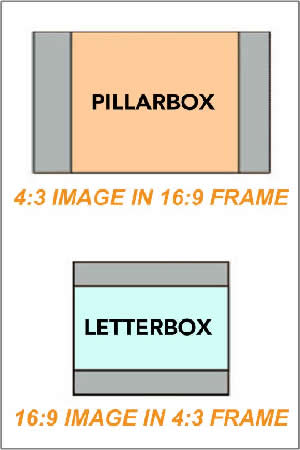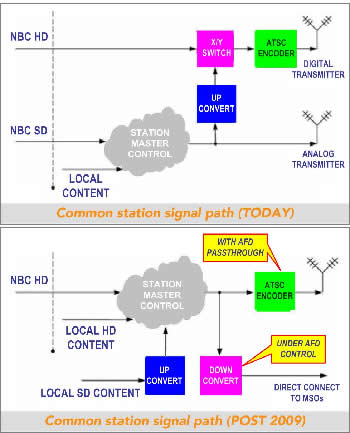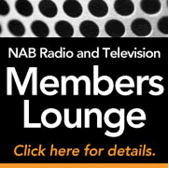|
Managing Aspect Ratio through Production and Distribution
The transition
to digital TV broadcasting is complicated by the fact that two
different aspect ratios, 4:3 and 16:9, are currently in use. A
session at the upcoming NAB Broadcast Engineering Conference (BEC,
April 12-17, 2008, Las Vegas, NV - see below for additional information)
entitled "Video Content Creation and Manipulation" includes
a paper by Larry Thaler, Vice President of Distribution Technology,
NBC Universal Inc. on "From Camera to the Home: Managing
Aspect Ratio Through the Production and Distribution Process,"
which describes how NBC Universal is meeting this challenge, and
which is excerpted here.
INTRODUCTION
- As the percentage of high definition televisions in the home
continues to grow, networks face increasing pressure to tailor
their programming for both the SD and HD audiences. High on this
list of challenges is aspect ratio. Programming will continue
to originate and will be distributed in both SD and HD formats
for years to come. Broadcasters must have a strategy that maximizes
production and distribution efficiencies while maintaining the
presentation quality for each home viewer, even though their screens
may differ greatly. This paper will describe steps that NBC Universal
has taken to prepare for this transition and makes recommendations
that stations can use as the transition approaches. It highlights
techniques available to every broadcaster and production company
that can ensure all programming is optimized for both the SD and
HD viewer.
 THE
CHALLENGE - When formatting an HD program for the SD audience,
the choices are normally center-cut (and produced center-cut safe)
or letterboxed (giving up roughly 1/3 of the SD screen - see figure
at right). Alternatively, when formatting an SD program for the
HD audience, the material is normally pillar-boxed (which can
sometimes result in home viewers stretching or zooming the content
to fill the screen). There are other options such as shooting
material in a compromise 14:9; however building a library in 14:9
may limit its value after the digital transition. Alternatively,
material may also be produced and edited twice (in each HD and
SD), but production costs make that approach prohibitive. THE
CHALLENGE - When formatting an HD program for the SD audience,
the choices are normally center-cut (and produced center-cut safe)
or letterboxed (giving up roughly 1/3 of the SD screen - see figure
at right). Alternatively, when formatting an SD program for the
HD audience, the material is normally pillar-boxed (which can
sometimes result in home viewers stretching or zooming the content
to fill the screen). There are other options such as shooting
material in a compromise 14:9; however building a library in 14:9
may limit its value after the digital transition. Alternatively,
material may also be produced and edited twice (in each HD and
SD), but production costs make that approach prohibitive.
ACTIVE
FORMAT DESCRIPTION - NBC needed a way to permit a show producer
to identify the format of the content upstream, and provide instructions
to the down-converter further downstream. The answer came in the
form of Active Format Description (AFD - see the June
4, 2007 issue of TV TechCheck for additional information
about AFD). NBC proposed to our vendors that we carry an AFD flag
in the Vertical Ancillary Data Space (VANC) of our HD video signals
in our upstream production equipment. Downstream, downconverters
would interpret this flag and automatically switch between 16:9
and 4:3 segments in real-time. This would produce an optimal viewing
experience to both SD and HD viewers with one set of production
facilities. AFD was inserted in the control room's embedder, which
is used to combine the audio and video signals after the production
switcher and audio console. NBC standardized on two main flags
("AFD Full 16:9" and "AFD 16:9 with 4:3 center")
to identify material that should be letterboxed or center cut
on down conversion.
All of NBC's
programming has been using AFD technology to produce the proper
down-converted aspect ratio since the fall season in 2006. Our
audience has been enjoying shows such as Heroes, Scrubs, SNL,
Late Night, Today and Nightly News with Brian Williams with the
SD version properly formatted by the production requirements.
 SKYPATH
HD - NBC's new "Skypath HD" system will be the next
step in the natural evolution to a fully high definition network.
Once Skypath HD is deployed, NBC programming will be distributed
to its broadcast affiliates exclusively in HD, simplifying the
distribution process. What makes this all possible is NBC's aforementioned
HD/SD infrastructure that has seamlessly incorporated AFD. A local
downconverter will generate the main NBC SD feed for its local
stations - presented at the proper aspect ratio under dynamic
AFD control. With almost 3 years of experience, we have faith
that these devices can reliably handle all aspects of the down-conversion
accurately. Once NBC's signal is fed primarily in HD, the local
stations' signal path will also evolve as shown in the block diagrams
to the right. SKYPATH
HD - NBC's new "Skypath HD" system will be the next
step in the natural evolution to a fully high definition network.
Once Skypath HD is deployed, NBC programming will be distributed
to its broadcast affiliates exclusively in HD, simplifying the
distribution process. What makes this all possible is NBC's aforementioned
HD/SD infrastructure that has seamlessly incorporated AFD. A local
downconverter will generate the main NBC SD feed for its local
stations - presented at the proper aspect ratio under dynamic
AFD control. With almost 3 years of experience, we have faith
that these devices can reliably handle all aspects of the down-conversion
accurately. Once NBC's signal is fed primarily in HD, the local
stations' signal path will also evolve as shown in the block diagrams
to the right.
This paper
will be presented on Tuesday, April 15, 2008 starting at 3 p.m.
in room S226/227 of the Las Vegas Convention Center. It will also
be included in its entirety in the 2008 NAB BEC Proceedings,
on sale at the 2008 NAB Show. For additional conference information
visit the NAB Show Web page at www.nabshow.com.
2008
NAB Broadcast Engineering Conference Summary of Presentations
Check out the papers
that will be presented at the 2008 NAB Broadcast Engineering Conference
in Las Vegas, April 12 -17, 2008.
Mobile TV: Opportunity at 100 MPH!
Monday, April 14
7:30
a.m. - 8:30 a.m.
Las Vegas Hilton Ballroom A
 The
Open Mobile Video Coalition (OMVC) invites engineers from television,
telcos, cable and OEMs to learn more about breakthroughs and milestones
in engineering, consumer interest and testing, as well as new
revenue opportunities in the fast approaching locally broadcast
Mobile TV world. Join them for breakfast
on Monday, April 14 in Ballroom A. The
Open Mobile Video Coalition (OMVC) invites engineers from television,
telcos, cable and OEMs to learn more about breakthroughs and milestones
in engineering, consumer interest and testing, as well as new
revenue opportunities in the fast approaching locally broadcast
Mobile TV world. Join them for breakfast
on Monday, April 14 in Ballroom A.

The
March 17, 2008 TV TechCheck is also available
in an Adobe Acrobat file.
Please click
here to read the Adobe Acrobat version of TV TechCheck.
|

